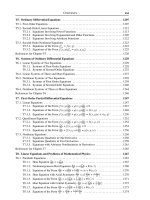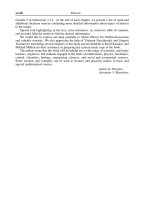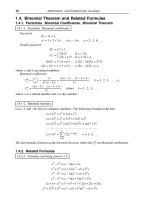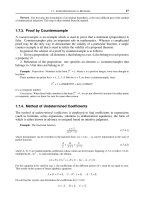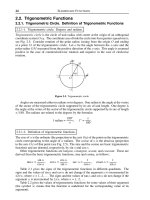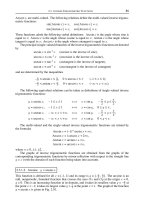Handbook of mathematics for engineers and scienteists part 202 ppsx
Bạn đang xem bản rút gọn của tài liệu. Xem và tải ngay bản đầy đủ của tài liệu tại đây (326.1 KB, 7 trang )
T10.4. SYSTEMS OF GENERAL FORM 1375
1
◦
. Solution:
u = ϕ(t)+c exp
f(t, bϕ – cψ) dt
θ(x, t), w = ψ(t)+b exp
f(t, bϕ – cψ) dt
θ(x, t),
where ϕ = ϕ(t)andψ = ψ(t) are determined by the system of ordinary differential equations
ϕ
t
= ϕf (t, bϕ – cψ)+g(t, bϕ – cψ),
ψ
t
= ψf(t, bϕ – cψ)+h(t, bϕ – cψ),
and the function θ = θ(x
1
, , x
n
, t) satisfi es linear equation
∂θ
∂t
= L[θ].
Remark 1. The coefficients of the linear differential operator L can be dependent on x
1
, , x
n
, t.
2
◦
. Let us multiply the first equation by b and the second one by –c and add the results
together to obtain
∂ζ
∂t
= L[ζ]+ζf(t, ζ)+bg(t, ζ)–ch(t, ζ), ζ = bu – cw.(1)
This equation will be considered in conjunction with the first equation of the original system
∂u
∂t
= L[u]+uf (t, ζ)+g(t, ζ). (2)
Equation (1) can be treated separately. Given a solution of this equation, ζ = ζ(x
1
, , x
n
, t),
the function u = u(x
1
, , x
n
, t) can be determined by solving the linear equation (2) and
the function w = w(x
1
, , x
n
, t) is found as w =(bu – ζ)/c.
Remark 2. Let L be a constant-coefficient differential operator with respect to the independent variable
x = x
1
and let the condition
∂
∂t
ζf(t, ζ)+bg(t, ζ)–ch(t, ζ)
= 0
hold true (for example, it is valid if the functions f , g, h are not implicitly dependent on t). Then equation (1)
admits an exact, traveling-wave solution ζ = ζ(z), where z = kx – λt with arbitrary constants k and λ.
2.
∂u
∂t
= L
1
[u] + uf
u
w
,
∂w
∂t
= L
2
[w] + wg
u
w
.
Here, L
1
and L
2
are arbitrary constant-coefficient linear differential operators (of any order)
with respect to x.
1
◦
. Solution:
u = e
kx–λt
y(ξ), w = e
kx–λt
z(ξ), ξ = βx – γt,
where k, λ, β,andγ are arbitrary constants and the functions y = y(ξ)andz = z(ξ)are
determined by the system of ordinary differential equations
M
1
[y]+λy + yf(y/z)=0, M
2
[z]+λz + zg(y/z)=0,
M
1
[y]=e
–kx
L
1
[e
kx
y(ξ)], M
2
[z]=e
–kx
L
2
[e
kx
z(ξ)].
To the special case k = λ = 0 there corresponds a traveling-wave solution.
2
◦
. If the operators L
1
and L
2
contain only even derivatives, there are solutions of the form
u =[C
1
sin(kx)+C
2
cos(kx)]ϕ(t), w =[C
1
sin(kx)+C
2
cos(kx)]ψ(t);
u =[C
1
exp(kx)+C
2
exp(–kx)]ϕ(t), w =[C
1
exp(kx)+C
2
exp(–kx)]ψ(t);
u =(C
1
x + C
2
)ϕ(t), w =(C
1
x + C
2
)ψ(t),
where C
1
, C
2
,andk are arbitrary constants. Note that the third solution is degenerate.
1376 SYSTEMS OF PARTIAL DIFFERENTIAL EQUATIONS
3.
∂u
∂t
= L[u] + uf
t,
u
w
,
∂w
∂t
= L[w] + wg
t,
u
w
.
Here, L is an arbitrary linear differential operator with respect to the coordinates x
1
, , x
n
(of any order in derivatives), whose coefficients can be dependent on x
1
, , x
n
, t:
L[u]=
A
k
1
k
n
(x
1
, , x
n
, t)
∂
k
1
+···+k
n
u
∂x
k
1
1
∂x
k
n
n
.(1)
1
◦
. Solution:
u = ϕ(t)exp
g(t, ϕ(t)) dt
θ(x
1
, , x
n
, t),
w =exp
g(t, ϕ(t)) dt
θ(x
1
, , x
n
, t),
(2)
where the function ϕ = ϕ(t) is described by the first-order nonlinear ordinary differential
equation
ϕ
t
=[f(t, ϕ)–g(t, ϕ)]ϕ,(3)
and the function θ = θ(x
1
, , x
n
, t) satisfi es the linear equation
∂θ
∂t
= L[θ].
2
◦
. The transformation
u = a
1
(t)U + b
1
(t)W , w = a
2
(t)U + b
2
(t)W ,
where a
n
(t)andb
n
(t) are arbitrary functions (n = 1, 2), leads to an equation of the similar
form for U and W .
Remark. The coefficients of the operator (1) can also depend on the ratio of the unknowns u/w, A
k
1
k
n
=
A
k
1
k
n
(x
1
, , x
n
, t, u/w) (in this case, L will be a quasilinear operator). Then there also exists a solution
of the form (2), where ϕ = ϕ(t) is described by the ordinary differential equation (3) and θ = θ(x
1
, , x
n
, t)
satisfies the linear equation
∂θ
∂t
= L
◦
[θ], L
◦
= L
u/w=ϕ
.
4.
∂u
∂t
= L[u] + uf
u
w
+ g
u
w
,
∂w
∂t
= L[w] + wf
u
w
+ h
u
w
.
Here, L is an arbitrary linear differential operator with respect to x
1
, , x
n
(of any order
in derivatives), whose coefficients can be dependent on x
1
, , x
n
, t:
L[u]=
A
k
1
k
n
(x
1
, , x
n
, t)
∂
k
1
+···+k
n
u
∂x
k
1
1
∂x
k
n
n
,
where k
1
+ ···+ k
n
≥ 1.
Let k be a root of the algebraic (transcendental) equation
g(k)=kh(k). (1)
1
◦
. Solution if f (k) ≠ 0:
u(x, t)=k
exp[f(k)t]θ(x, t)–
h(k)
f(k)
, w(x, t)=exp[f(k)t]θ(x, t)–
h(k)
f(k)
,
T10.4. SYSTEMS OF GENERAL FORM 1377
where the function θ = θ(x
1
, , x
n
, t) satisfi es the linear equation
∂θ
∂t
= L[θ]. (2)
2
◦
. Solution if f (k)=0:
u(x, t)=k[θ(x, t)+h(k)t], w(x, t)=θ(x, t)+h(k)t,
where the function θ = θ(x
1
, , x
n
, t) satisfi es the linear equation (2).
5.
∂u
∂t
= L[u]+uf
t,
u
w
+
u
w
h
t,
u
w
,
∂w
∂t
= L[w]+wg
t,
u
w
+h
t,
u
w
.
Solution:
u = ϕ(t)G(t)
θ(x
1
, , x
n
, t)+
h(t, ϕ)
G(t)
dt
, G(t)=exp
g(t, ϕ) dt
,
w = G(t)
θ(x
1
, , x
n
, t)+
h(t, ϕ)
G(t)
dt
,
where the function ϕ = ϕ(t) is described by the first-order nonlinear ordinary differential
equation
ϕ
t
=[f(t, ϕ)–g(t, ϕ)]ϕ,
and the function θ = θ(x
1
, , x
n
, t) satisfi es the linear equation
∂θ
∂t
= L[θ].
6.
∂u
∂t
= L[u] + uf
t,
u
w
ln u + ug
t,
u
w
,
∂w
∂t
= L[w] + wf
t,
u
w
ln w + wh
t,
u
w
.
Solution:
u(x, t)=ϕ(t)ψ(t)θ(x
1
, , x
n
, t), w(x, t)=ψ(t)θ(x
1
, , x
n
, t),
where the functions ϕ=ϕ(t)andψ =ψ(t) are determined by solving the ordinary differential
equations
ϕ
t
= ϕ[g(t, ϕ)–h(t, ϕ)+f(t, ϕ)lnϕ],
ψ
t
= ψ[h(t, ϕ)+f(t, ϕ)lnψ],
(1)
and the function θ = θ(x
1
, , x
n
, t) is determined by the differential equation
∂θ
∂t
= L[θ]+f(t, ϕ)θ ln θ.(2)
Givenasolutiontothefirst equation in (1), the second equation can be solved with the change
of variable ψ = e
ζ
by reducing it to a linear equation for ζ.IfL is a constant-coefficient
one-dimensional operator (n = 1)andf = const, then equation (2) has a traveling-wave
solution θ = θ(kx – λt).
1378 SYSTEMS OF PARTIAL DIFFERENTIAL EQUATIONS
7. F
1
w,
∂w
∂x
, ,
∂
m
w
∂x
m
,
1
u
k
∂w
∂t
,
1
u
∂u
∂x
, ,
1
u
∂
n
u
∂x
n
=0,
F
2
w,
∂w
∂x
, ,
∂
m
w
∂x
m
,
1
u
k
∂w
∂t
,
1
u
∂u
∂x
, ,
1
u
∂
n
u
∂x
n
=0.
Solution:
w = W (z), u =[ϕ
(t)]
1/k
U(z), z = x + ϕ(t),
where ϕ(t) is an arbitrary function, and the functions W (z)andU (z) are determined by the
autonomous system of ordinary differential equations
F
1
W , W
z
, , W
(m)
z
, W
z
/U
k
, U
z
/U, , U
(n)
z
/U
= 0,
F
2
W , W
z
, , W
(m)
z
, W
z
/U
k
, U
z
/U, , U
(n)
z
/U
= 0.
T10.4.3. Nonlinear Systems of Two Equations Involving the Second
Derivatives in
t
1.
∂
2
u
∂t
2
= L[u] + uf(t, au – bw) + g(t, au – bw),
∂
2
w
∂t
2
= L[w] + wf(t, au – bw) + h(t, au – bw).
Here, L is an arbitrary linear differential operator (of any order) with respect to the spatial
variables x
1
, , x
n
, whose coefficients can be dependent on x
1
, , x
n
, t. It is assumed
that L[const] = 0.
1
◦
. Solution:
u = ϕ(t)+aθ(x
1
, , x
n
, t), w = ψ(t)+bθ(x
1
, , x
n
, t),
where ϕ = ϕ(t)andψ = ψ(t) are determined by the system of ordinary differential equations
ϕ
tt
= ϕf (t, aϕ – bψ)+g(t, aϕ – bψ),
ψ
tt
= ψf(t, aϕ – bψ)+h(t, aϕ – bψ),
and the function θ = θ(x
1
, , x
n
, t) satisfi es linear equation
∂
2
θ
∂t
2
= L[θ]+f(t, aϕ – bψ)θ.
2
◦
. Let us multiply the fi rst equation by a and the second one by –b and add the results
together to obtain
∂
2
ζ
∂t
2
= L[ζ]+ζf(t, ζ)+ag(t, ζ)–bh(t, ζ), ζ = au – bw.(1)
This equation will be considered in conjunction with the first equation of the original system
∂
2
u
∂t
2
= L[u]+uf(t, ζ)+g(t, ζ). (2)
T10.4. SYSTEMS OF GENERAL FORM 1379
Equation (1) can be treated separately. Given a solution ζ = ζ(x, t) to equation (1), the
function u = u(x
1
, , x
n
, t) can be determined by solving the linear equation (2) and the
function w = w(x
1
, , x
n
, t) is found as w =(au – ζ)/b.
Note three important cases where equation (1) admits exact solutions:
(i) Equation (1) admits a spatially homogeneous solution ζ = ζ(t).
(ii) Suppose the coeffi cients of L and the functions f , g, h are not implicitly dependent
on t. Then equation (1) admits a steady-state solution ζ = ζ(x
1
, , x
n
).
(iii) If the condition ζf(t, ζ)+bg(t, ζ)–ch(t, ζ)=k
1
ζ + k
0
holds, equation (1) is linear.
If the operator L is constant-coefficient, the method of separation of variables can be used
to obtain solutions.
2.
∂
2
u
∂t
2
= L
1
[u] + uf
u
w
,
∂
2
w
∂t
2
= L
2
[w] + wg
u
w
.
Here, L
1
and L
2
are arbitrary constant-coefficient linear differential operators (of any order)
with respect to x. It is assumed that L
1
[const] = 0 and L
2
[const] = 0.
1
◦
. Solution in the form of the product of two waves traveling at different speeds:
u = e
kx–λt
y(ξ), w = e
kx–λt
z(ξ), ξ = βx – γt,
where k, λ, β,andγ are arbitrary constants, and the functions y = y(ξ)andz = z(ξ)are
determined by the system of ordinary differential equations
γ
2
y
ξξ
+ 2λγy
ξ
+ λ
2
y = M
1
[y]+yf(y/z), γ
2
z
ξξ
+ 2λγz
ξ
+ λ
2
z = M
2
[z]+zg(y/z),
M
1
[y]=e
–kx
L
1
[e
kx
y(ξ)], M
2
[z]=e
–kx
L
2
[e
kx
z(ξ)].
To the special case k = λ = 0 there corresponds a traveling-wave solution.
2
◦
. Periodic multiplicative separable solution:
u =[C
1
sin(kt)+C
2
cos(kt)]ϕ(x), w =[C
1
sin(kt)+C
2
cos(kt)]ψ(x),
where C
1
, C
2
,andk are arbitrary constants and the functions ϕ = ϕ(x)andψ = ψ(x)are
determined by the system of ordinary differential equations
L
1
[ϕ]+k
2
ϕ + ϕf(ϕ/ψ)=0,
L
2
[ψ]+k
2
ψ + ψg(ϕ/ψ)=0.
3
◦
. Multiplicative separable solution:
u =[C
1
sinh(kt)+C
2
cosh(kt)]ϕ(x), w =[C
1
sinh(kt)+C
2
cosh(kt)]ψ(x),
where C
1
, C
2
,andk are arbitrary constants and the functions ϕ = ϕ(x)andψ = ψ(x)are
determined by the system of ordinary differential equations
L
1
[ϕ]–k
2
ϕ + ϕf(ϕ/ψ)=0,
L
2
[ψ]–k
2
ψ + ψg(ϕ/ψ)=0.
4
◦
. Degenerate multiplicative separable solution:
u =(C
1
t + C
2
)ϕ(x), w =(C
1
t + C
2
)ψ(x),
1380 SYSTEMS OF PARTIAL DIFFERENTIAL EQUATIONS
where C
1
and C
2
are arbitrary constants and the functions ϕ = ϕ(x)andψ = ψ(x)are
determined by the system of ordinary differential equations
L
1
[ϕ]+ϕf(ϕ/ψ)=0, L
2
[ψ]+ψg(ϕ/ψ)=0.
Remark 1. The coefficients of L
1
, L
2
and the functions f and g in Items 2
◦
–4
◦
can be dependent on x.
Remark 2. If L
1
and L
2
contain only even derivatives, there are solutions of the form
u =[C
1
sin(kx)+C
2
cos(kx)]U(t), w =[C
1
sin(kx)+C
2
cos(kx)]W (t);
u =[C
1
exp(kx)+C
2
exp(–kx)]U(t), w =[C
1
exp(kx)+C
2
exp(–kx)]W (t);
u =(C
1
x + C
2
)U(t), w =(C
1
x + C
2
)W (t),
where C
1
, C
2
,andk are arbitrary constants. Note that the third solution is degenerate.
3.
∂
2
u
∂t
2
= L[u] + uf
t,
u
w
,
∂
2
w
∂t
2
= L[w] + wg
t,
u
w
.
Here, L is an arbitrary linear differential operator with respect to the coordinates x
1
, , x
n
(of any order in derivatives), whose coefficients can be dependent on the coordinates.
Solution:
u = ϕ(t)θ(x
1
, , x
n
),
w = ψ(t)θ(x
1
, , x
n
),
where the functions ϕ = ϕ(t)andψ = ψ(t) are described by the nonlinear system of
second-order ordinary differential equations
ϕ
tt
= aϕ + ϕf(t, ϕ/ψ),
ψ
tt
= aψ + ψg(t, ϕ/ψ),
a is an arbitrary constant, and the function θ = θ(x
1
, , x
n
) satisfies the linear steady-state
equation
L[θ]=aθ.
4.
∂
2
u
∂t
2
= L[u] + uf
u
w
+ g
u
w
,
∂
2
w
∂t
2
= L[w] + wf
u
w
+ h
u
w
.
Here, L is an arbitrary linear differential operator with respect to the coordinates x
1
, , x
n
(of any order in derivatives), whose coefficients can be dependent on x
1
, , x
n
, t.
Solution:
u = kθ(x
1
, , x
n
, t), w = θ(x
1
, , x
n
, t),
where k is a root of the algebraic (transcendental) equation g(k)=kh(k) and the function
θ = θ(x, t) satisfies the linear equation
∂
2
θ
∂t
2
= L[θ]+f(k)w + h(k).
5.
∂
2
u
∂t
2
= L[u] + au ln u + uf
t,
u
w
,
∂
2
w
∂t
2
= L[w] + aw ln w + wg
t,
u
w
.
Here, L is an arbitrary linear differential operator with respect to the coordinates x
1
, , x
n
(of any order in derivatives), whose coefficients can be dependent on the coordinates.
T10.4. SYSTEMS OF GENERAL FORM 1381
Solution:
u = ϕ(t)θ(x
1
, , x
n
),
w = ψ(t)θ(x
1
, , x
n
),
where the functions ϕ = ϕ(t)andψ = ψ(t) are described by the nonlinear system of
second-order ordinary differential equations
ϕ
tt
= aϕ ln ϕ + bϕ + ϕf(t, ϕ/ψ),
ψ
tt
= aψ ln ψ + bψ + ψg(t, ϕ/ψ),
b is an arbitrary constant, and the function θ = θ(x
1
, , x
n
) satisfies the steady-state
equation
L[θ]+aθ ln θ – bθ = 0.
T10.4.4. Nonlinear Systems of Many Equations Involving the First
Derivatives in
t
1.
∂u
m
∂t
= L[u
m
] + u
m
f(t, u
1
– b
1
u
n
, , u
n–1
– b
n–1
u
n
)
+ g
m
(t, u
1
– b
1
u
n
, , u
n–1
– b
n–1
u
n
), m =1, , n.
The system involves n + 1 arbitrary functions f, g
1
, , g
n
that depend on n arguments;
L is an arbitrary linear differential operator with respect to the spatial variables x
1
, , x
n
(of any order in derivatives), whose coefficients can be dependent on x
1
, , x
n
, t.Itis
assumed that L[const] = 0.
Solution:
u
m
= ϕ
m
(t)+exp
f(t, ϕ
1
– b
1
ϕ
n
, , ϕ
n–1
– b
n–1
ϕ
n
) dt
θ(x
1
, , x
n
, t).
Here, the functions ϕ
m
= ϕ
m
(t) are determined by the system of ordinary differential
equations
ϕ
m
= ϕ
m
f(t, ϕ
1
– b
1
ϕ
n
, , ϕ
n–1
– b
n–1
ϕ
n
)+g
m
(t, ϕ
1
– b
1
ϕ
n
, , ϕ
n–1
– b
n–1
ϕ
n
),
where m = 1, , n, the prime denotes the derivative with respect to t, and the function
θ = θ(x
1
, , x
n
, t) satisfies the linear equation
∂θ
∂t
= L[θ].
2.
∂u
m
∂t
= L[u
m
] + u
m
f
m
t,
u
1
u
n
, ,
u
n–1
u
n
+
u
m
u
n
g
t,
u
1
u
n
, ,
u
n–1
u
n
,
∂u
n
∂t
= L[u
n
] + u
n
f
n
t,
u
1
u
n
, ,
u
n–1
u
n
+ g
t,
u
1
u
n
, ,
u
n–1
u
n
.
Here, m = 1, , n – 1 and the system involves n + 1 arbitrary functions f
1
, , f
n
, g
that depend on n arguments; L is an arbitrary linear differential operator with respect to
the spatial variables x
1
, , x
n
(of any order in derivatives), whose coefficients can be
dependent on x
1
, , x
n
, t. It is assumed that L[const] = 0.



